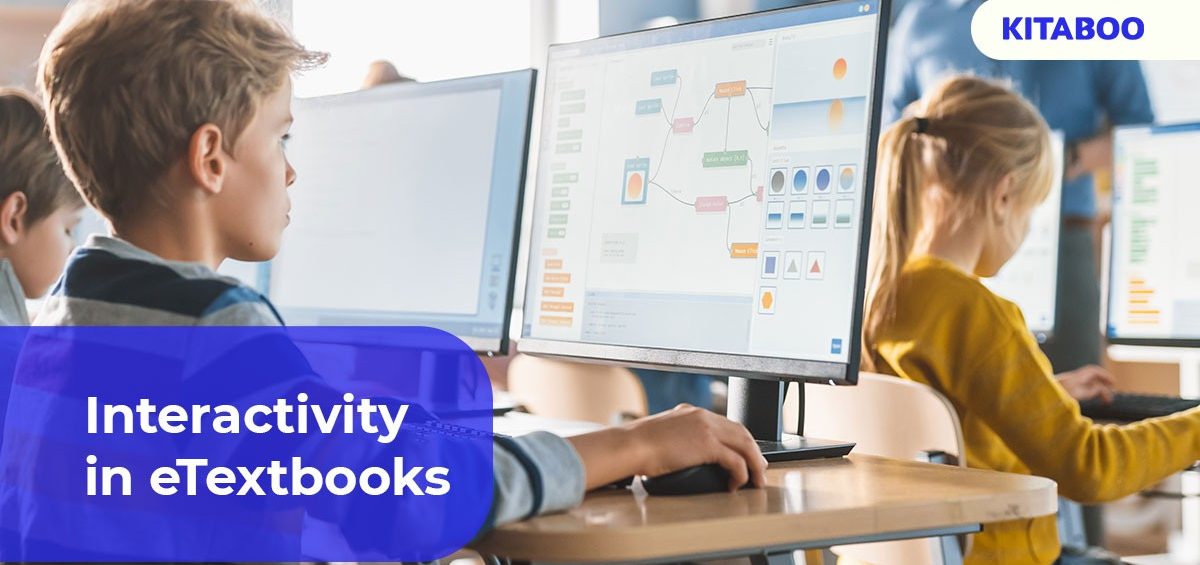From paperbacks to eBooks, textbooks have undergone a massive revolution. Now, eTextbooks are available. And they come with one distinct feature; interactivity.
According to Blummer & Kenton, 2020, interactive eBooks increase a student’s access to information. In addition, they positively impact the processes of reading, learning, analyzing, and conducting research.
Besides this, interactive eTextbooks have numerous other benefits for students. In this article we’ll explore some of these, and discover how they enhance the learning experience for K12 students.
Here’s what’s in store for you.
Table of Contents
- How Interactive eTextbooks Enhance the Learning Experience
How Interactive eTextbooks Enhance the Learning Experience
As we all know and might have experienced, interactivity by nature increases engagement. However, there’s a little more to it as well. Here’s a look at how exactly the interactivity of eTextbooks can enhance the learning experience.
Interactive Tools
When studying from a regular book or eBook, there’s a limit to what one can achieve. However, with interactive eBooks come a range of features and tools that are designed specifically to make learning better. Here are a few examples:
- Markup features like pen and annotations tools
- Features to adjust adjusting the brightness, font size and magnification(zoom) of the text
- Tools to search for information easily
- Tools to add digital bookmarks anywhere within the content
These tools make it easier for students to highlight important points, make notes and better process the subject-matter.
Enhancing Comprehension
According to research, eBooks ensure efficient information retention and improve a students’ performance. This can perhaps be attributed to the use of multimedia and interactive storytelling.
Interactive eBooks use video, audio, animations and so on, to explain complex concepts in a simplified manner through storytelling. Students also have the option of pausing or rewatching these videos as well as reattempting practice tests.
All this helps deepen their comprehension of the topic.
Encouraging Interactions between Teachers and Taught
Surprisingly enough, eTextbooks actually encourage digital interactions between teachers and students. Learners can leave comments on a topic which educators can then address. Apart from that eTextbooks also allow for group discussions and forums that foster collaboration.
These digital interactions give educators clues as to the actual effort put in by the student as well as their comprehension levels.
All this increases interactivity during the K12 learning journey between teachers, students and amongst fellow students.
The Possibility of Customization
The customization of eTextbooks is a two-fold aspect.
On the one hand, educators can customize the content in an eBook with audio, interactive storytelling, and other such features. On the other hand, every student has a personal, individual learning style that eTextbooks must cater to.
Interactive eBooks manage to cater to both these requirements with ease.
A Variety of Assessment Methods
In any course, at any age, the ability to correctly assess a learner is crucial. As they say, if you judge a fish by its ability to climb a tree, it will spend its whole life believing it’s stupid.
In traditional learning, every student is judged on the basis of their ability to answer questions of the specified format. However, in online learning educators can use multiple assessment techniques to judge the level of comprehension of a student.
The variety of assessment methods that eTextbooks allow, help level the playing field. K12 students can be assessed on the basis of quick quizzes, game-based learning, practical understanding and so on.
Moreover, a student can sometimes also receive the results of a test immediately. This immediate feedback saves on time and helps students evaluate for themselves the topics they need to improve on.
Augmented Reality
Augmented reality (AR) in interactive eBooks transforms 2D images into 3D.
A student with an AR-enabled smartphone only needs to point at an image (for example, the human brain), and is shown a 3D version of it. From there, they can enjoy viewing the brain from all angles and make note of its intricacies.
This level of interactivity provides an eReading experience that engages both a students’ cognitive and sensory processes.
Quick Upgradation of Content
With printed textbooks, a student needs to wait for the new updated version to become available. Fortunately, the advent of eTextbooks has curbed this time lag.
With eBooks, content can be updated quickly without much effort.
For instance, whenever there is a new finding in the subject matter of AI, digital content creators can deploy their digital assets to incorporate this into the existing content. This keeps the students and teachers up-to-date with new information and learning.
Ease of Access
Once a student makes the transition to digital learning, there’s no looking back. As we’re all aware, eBooks are easy to carry around and can be accessed from multiple devices.
This allows students to study in multiple situations that would previously not have been possible. E.g.- In a crowded space.
Additionally, storing study-material is made much easier with eBooks.
Cost-Effective and Environmental-Friendly
In comparison to printed textbooks, eBooks are quite inexpensive as the cost of their production and distribution is much less.
Interactive eTextbooks also save the environment. A significant portion of cut trees are used specifically for the paper industry.
Fortunately, this can be avoided in the case of eBooks, where no printing is required as they are available in a digital format.
Conclusion
eLearning has taken over the K12 education system and it’s plain to see why. Interactive eBooks not only enhance the learning experience but are also designed based on strategies to improve student learning outcomes. As a K12 educator or publisher, it’s time to take advantage of interactive eTextbooks.
One way to do this is by using KITABOO, a secure digital publishing platform that helps transform regular content into interactive material. KITABOO helps create, publish and distribute eLearning content.
To know more on how to achieve interactivity in your eTextbooks, write to us at KITABOO@hurix.com.
Discover How An Ebook Conversion, Publishing & Distribution Platform Can Help You
Kitaboo is a cloud-based content platform to create-publish & securely distribute interactive mobile-ready ebooks.
You May Also Like







